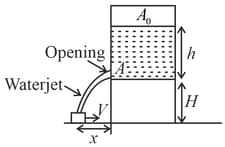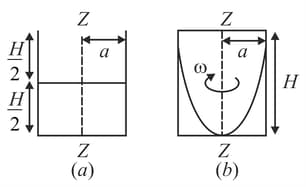What is difference between fluid statics and fluid dynamics?
Important Questions on Mechanical Properties of Fluids
Consider the configuration of a stationary water tank of cross-section area and a small bucket as shown in figure below;

What should be the speed of the bucket, so that the water leaking out of a hole of cross-section area (as shown) from the water tank does not fall outside the bucket?
(Take, and ).
A cylinder of radius and height is filled with a liquid to an unknown height When it is rotated at an unknown constant angular velocity the base of the cylinder gets exposed when the liquid just starts spilling out, as shown in figure.
(a) Find the height of the liquid.
(b) Find the angular speed of the cylinder.

Consider the following statements:
1. Taking into account, the fact that any object which floats must have an average density less than that of water during World War 1, a number of cargo vessels were made of concrete.
2. Concrete cargo vessels were filled with air.
3. A ship floats higher in the water on a high-pressure day than on a low-pressure day.
4. Floating of the ship in the water is not possible because of the buoyancy force which is present due to pressure difference.
Which of the statements given above are correct?
Assertion: Gases also behave as fluids.
Reason: Gas molecules are bounded by cohesive forces.
Assertion: Pressurized fluid contains energy.
Reason: Work must be done to compress fluids.
Assertion: Under steady flow, the velocity of the particle of fluid is not constant at a point.
Reason: Ideal fluids are compressible.

